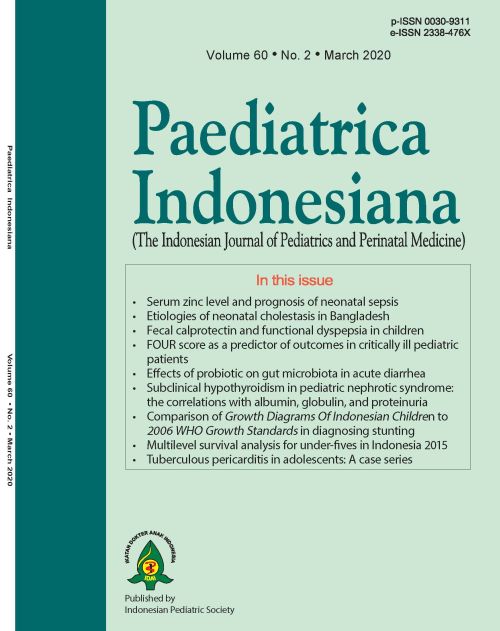Etiologies of neonatal cholestasis at a tertiary hospital in Bangladesh
Abstract
Background Neonatal cholestasis is an important etiology of chronic liver disease in young children. It has a varied etiology. There is considerable delay in presentation and diagnosis of neonatal cholestasis in Bangladesh. Lack of awareness and knowledge among the pediatricians regarding etiological diagnosis and outcome of neonatal cholestasis is the reasons for poor outcome in major portion of cases in Bangladesh.
Objective To evaluate the etiological spectrum of neonatal cholestasis.
Methods This retrospective study was conducted at the Department of Pediatric Gastroenterology and Nutrition, Bangabandhu Sheikh Mujib Medical University (BSMMU), Dhaka, Bangladesh. We reviewed medical records of children who were diagnosed with neonatal cholestasis. Complete diagnostic profiles of every cases with age of presentation, male-female ratio and final diagnosis were analyzed.
Results A total of 114 children with neonatal cholestasis were evaluated. Subjects' male-female ratio was 1.92: 1.0, and mean age at hospitalization was 92.7 (SD 39.5) days. Biliary atresia was the most common etiology (47.4%), followed by idiopathic neonatal hepatitis/INH (21.9%). Other identified etiologies were, toxoplasmosis, others (syphilis, varicella-zoster, parvovirus b19), rubella, cytomegalovirus (CMV), and herpes/TORCH infection (8.61%), progressive familial intrahepatic cholestasis/PFIC (4.4%), galactosemia (4.4%), choledochal cyst (3.5%), sepsis (1.8%), urinary tract infection/UTI (1.8%), hypothyroidism (1.8%), lipid storage disease/Niemann-Pick disease (0.9%), non-syndromic paucity of interlobular bile ducts (2.67%), and Caroli's disease (0.9%).
Conclusion In Bangladesh, neonatal cholestasis cases are most often due to obstructive causes, particularly biliary atresia. Idiopathic (INH), infectious (primarily TORCH), metabolic, and endocrine causes followed in terms of frequency.
References
2. Bhatia V, Bavdekar A, Matthai S, Waikar Y, Sibal A. Management of neonatal cholestasis: consensus statement of the Pediatric Gastroenterology Chapter of Indian Academy of Pediatrics. Indian Pediatr. 2014;51:203-10. DOI: 10.1007/s13312-014-0375-2.
3. Matthai J, Paul S. Evaluation of cholestatic jaundice in young infants. Indian Pediatr. 2001;38:893-8.
4. Bazlul Karim AS, Kamal M. Cholestatic jaundice during infancy: experience at a tertiary-care center in Bangladesh. Indian J Gastroenterol. 2005;24:52-4.
5. Kelly DA, Stanton A. Jaundice in babies: implications for community screening for biliary atresia. BMJ. 1995;310:1172–3. DOI: 10.1136/bmj.310.6988.1172.
6. Young S, Azzam RK. Infantile cholestasis: approach and diagnostic algorithm. In: Guandalini S, Dhawan A, Branski D, editors. Textbook of pediatric gastroenterology, hepatology and nutrition. Cham: Springer International Publishing; 2016. p. 625-31.
7. Davis AR, Rosenthal P, Escobar GJ, Newman TB. Interpreting conjugated bilirubin levels in newborns. J Pediatr. 2011;158:562-5. DOI: 10.1016/j.jpeds.2010.09.061.
8. Mowat AP. Liver disorders in childhood. Oxford: Butterworth-Heinemann; 1994. p. 43-78.
9. Dick MC, Mowat AP. Hepatitis syndrome in infancy – an epidemiological survey with 10 year follow up. Arch Dis Child. 1985;60:512–6. DOI: 10.1136/abc.60.6.512.
10. Danks DM, Campbell PE, Jack I, Rogers J, Smith AL. Studies of the aetiology of neonatal hepatitis and biliary atresia. Arch Dis Child. 1977;52:360–7. DOI: 10.1136/abc.52.5.360.
11. Jimenez-Rivera C, Jolin-Dahel KS, Fortinsky KJ, Gozdyra P, Benchimol EI. International incidence and outcomes of biliary atresia. J Pediatr Gastroenterol Nutr. 2013;56:344–54. DOI: 10.1097/MPG.0b013e318282a913.
12. Stormon MO, Dorney SF, Kamath KR, O’Loughlin EV, Gaskin KJ. The changing pattern of diagnosis of infantile cholestasis. J Paediatr Child Health. 2001;37:47–50. DOI: 10.1046/j.1440-1754.2001.00613.
13. Zani-Ruttenstock E, Mark Davenport. Biliary atresia and choledochal malformations. In: Guandalini S, Dhawan A, Branski D, editors. Textbook of pediatric gastroenterology, hepatology and nutrition. Switzerland: Springer International Publishing; 2016. p. 633-45.
14. Jain M, Adkar S, Waghmare C, Jain J, Jain S, Jain K, et al. Neonatal cholestasis - single centre experience in Central India. Indian J Community Med. 2016;41:299-301. DOI: 10.4103/0970-0218.193331.
15. Rafeey M, Golzar A, Javadzadeh A. Cholestatic syndrome of infancy. Pak J Biol Sci. 2008:11:1764-7. DOI: 10.3923/pjbs.2008.1764.1767.
16. Yachha SK. Consensus report on neonatal cholestasis syndrome. Indian Pediatr. 2000;37:845-51.
17. Arora NK, Arora S, Ahuja A, Mathur P, Maheshwari M, Das MK, et al. Alpha 1 antitrypsin deficiency in children with chronic liver disease in North India. Indian Pediatr. 2010;47:1015-23.
18. Yachha SK, Sharma A. Neonatal cholestasis in India. Indian Pediatr. 2005;42:491-2. PMID: 15923700.
19. Mahmud S, Ahmed SS, Parvez M, Tasneem F, Afroz M. Etiology of neonatal cholestasis: an experience in a tertiary centre of Bangladesh. Dhaka Shishu (Children) Hospital J. 2016;3222-6.
20. Mieli-Vergani G, Howard ER, Portman B, Mowat AP. Late referral for biliary atresia – missed opportunities for effective surgery. Lancet. 1989;1:421–3. DOI: 10.1016/s0140-6736(89)90012-3.
21. Stormon MO, Dorney SF, Kamath KR, O’Loughlin EV, Gaskin KJ. The changing pattern of diagnosis of infantile cholestasis. J Paediatr Child Health. 2001;37:47–50. DOI: 10.1046/j.1440-1754.2001.00613.
22. Gottesman LE, Del Vecchio MT, Aronoff SC. Etiologies of conjugated hyperbilirubinemia in infancy: a systematic review of 1692 subjects. BMC Pediatr. 2015;15:192. DOI: 10.1186/s12887-015-0506-5.
Copyright (c) 2020 Md. Benzamin, Mukesh Khadga, Fahmida Begum, Md. Rukunuzzaman, Md. Wahiduzzaman Mazumder, Khan Nahid Lamia, Md. Saidul Islam, AZM Raihanur Rahman, ASM Bazlul Karim

This work is licensed under a Creative Commons Attribution-NonCommercial-ShareAlike 4.0 International License.
Authors who publish with this journal agree to the following terms:
Authors retain copyright and grant the journal right of first publication with the work simultaneously licensed under a Creative Commons Attribution License that allows others to share the work with an acknowledgement of the work's authorship and initial publication in this journal.
Authors are able to enter into separate, additional contractual arrangements for the non-exclusive distribution of the journal's published version of the work (e.g., post it to an institutional repository or publish it in a book), with an acknowledgement of its initial publication in this journal.
Accepted 2020-02-28
Published 2020-02-28













